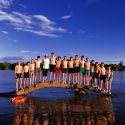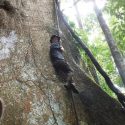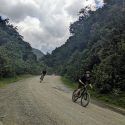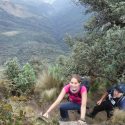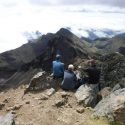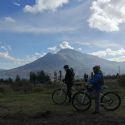In mid-July, a party of ten cadets from Budmouth College CCF departed for the High Andes and Amazon of Ecuador. The advice to ‘be ready for the unexpected’ was barely delivered before it became apparent that two packs had somehow gone missing in transit. Unfortunately, at 3000m with night time temperatures close to freezing, Quito is an uncomfortable place for rough sleepers!
Ecuador promised some world class mountain biking routes many of which, descending many thousands of feet, start in glacial and end in tropical conditions. You can literally start the route in thermals and end the day cycling in shorts applying bug repellent. Our programme included five major trails which were chosen to become increasingly challenging so promoting our acclimatization for climbing. Cumbaya (19 miles 1200m descent); Tandayapa (25 miles, 2000m descent) which took us through four climatic zones including a cloud forest; Antisana (20 miles 2000m ascent) which was a day of near vertical climbing; Octavalo (22 miles, 1000m descent) which led us to the biggest market in the country; and Quilotoa (18 miles, 2000m descent). This final ride of eight hours took us over four mountain passes and into a volcanic crater now filled with an emerald green lagoon. Mountain biking was the very best way to see the countryside, improve our performance at altitude and meet some of the people in the small villages that provided our rest stops. Crashes were frequent but fortunately severe damage was limited.
One of the surprises of Ecuador is the ease of access to so many climbs within a reasonable bus journey along the Pan American Highway through the Valley of the Volcanos. With scores of peaks to choose from, some over 20,000ft and including many active volcanos, we were spoilt for choice. It is even possible to opt for summits in the Cordillera Occidental (the west) or the Cordillera Oriental (the east) depending on the weather.
Our climbing started with an ascent of Pasochoa a huge long extinct volcano well south of Quito. The ascent began with a trail through humid forest which led to steep open slopes and eventually to a series of rock climbs to the summit. From here, the edge dropped away sharply giving views inside the crater where the last remnants of the primary Andean forest in Ecuador are to be found.
The second climb found us on Padre Encantado a huge ancient volcanic peak now much weathered. The approach started at the end of a track in open countryside from which you could clearly see the summit, a sharp peak comprising exposed rock and the remnants of lava flows, some six hours away. The final ridge provided great views on all sides with some sixteen high Andean summits visible. Here the effects of altitude were very obvious throughout the group, with some cadets gasping for oxygen and occasionally vomiting.
Full acclimatization can take six weeks but it was becoming clear that our physical performance was much improved within two climbs. This became obvious as a cable car whisked us up for to the lower slopes of Pichincha to 4200m to start our third climb. This was an active volcano which regularly covers the capital city with ash and used to close the city centre airport. The mountain was covered in seismic measuring stations and refuge signs warn climbers of the potential dangers of poisonous gas eruptions. As we approached the crater rim, you could clearly smell the hydrogen sulphide billowing up from the activity below. Our descent proved rapid and great fun, as we used volcanic ash slopes to descend hundreds of metres in minutes.
Our final climb was to be Illiniza but here dramatic climatic change was destabilising the ice done at the summit provoking frequent rockfalls. A whole series of accidents to other climbing groups, including one helicopter rescue in the previous week, meant that we had to rethink our final objective.
El Corazon is a huge ice capped mountain of rock clearly visible from the Pan American. From the roadhead the approach and ascent to the upper rock bands are very exposed, ice covered and windswept It is a climb that we treated with respect as throughout the day conditions kept changing and frequently, we were left with little or no visibility. It is also a peak that some years ago had claimed the life of another English student. After five hours of climbing we reached several rock falls joined by a very narrow ledge leading through several scrambles to the summit.
Following our adventures in the High Andes we descended into the Amazon for a week of jungle school. On both sides of the border between Ecuador and Colombia, a battle is underway against criminal organizations linked to drug trafficking and the demise of the FARC, so the local towns are swamped by troops. To add a little spice to our travels, the Ecuadorian Marines from the Jungle Warfare and Counter-insurgency School (located hundreds of miles from any ocean) insisted that we be accompanied by an officer in plain clothing who could check for signs of narco trafficking activity along the backwaters of our route.
Our days started with a canoe journey deeper into the Amazon where as evening approached we would locate a potential campsite. Once unloaded we set about clearing sufficient forest to allow for our camp to be erected and then we would practice the techniques of fishing and hunting so essential for successful jungle survival. As soon as you disembarked the moving canoe the heat and humidity were immediately stifling and to add to our discomfort, hordes of insects flocked to join us. Ants were everywhere and one colony, their trail obstructed by a tent, actually managed to eat their way through. The afternoon always brought a major storm with lightning bolts illuminating the sky and river. To say it was an uncomfortable existence would be an understatement but much was learnt and the basics of jungle survival were rapidly grasped.
Our jungle school ended on a misty morning cruising at high speed towards an invisible beach and transport that would take us across both chains of the Andes and onto the coastal lowlands. The escape from oppressive heat was greatly welcomed until misfunctioning hotel electrics managed to start a room fire in our first rest stop. Luckily the fire was discovered before the hotel disappeared and a quick-thinking cadet managed to extinguish the blaze.
Jungle living was now gratefully exchanged for a relative ‘life of leisure’ on the Pacific Coast of Manabí. Here for a week we lived on the beach, taking daily local transport many miles down the coast to collect provisions, book transport and send emails. Meals were cooked over a large fire of driftwood and the flames and sound of the bagpipes attracted considerable attention. Our days on the beach were spent swimming and surfing as well as successfully playing football, volleyball and cricket against the locals. Clearly looking to even the score, some returned after dark to remove all our trainers! Pacific humpback whales spend June to September in these warm coastal waters, mating and giving birth to their young and on the last day, one came inshore to perform an incredible display in the shallow waters opposite our campsite.
For the last two days we travelled back up into the Andes to to Quito to undertake trips to ‘the Centre of the World’ (ironically wrongly located), barter for presents and have a fabulous presentation dinner at the Hilton to round off our five-week adventure. There was not a cadet awake as we lifted off for our return to London.


